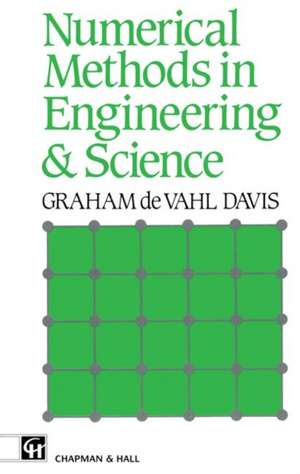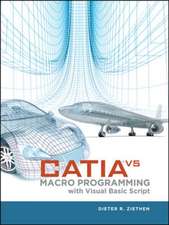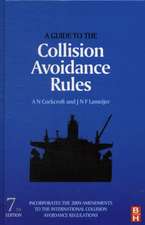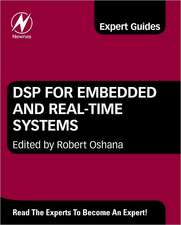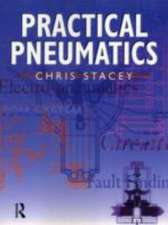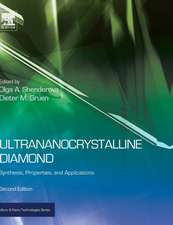Numerical Methods in Engineering & Science
Editat de Graham de Vahl Davisen Limba Engleză Paperback – 20 noi 1986
Preț: 388.52 lei
Nou
Puncte Express: 583
Preț estimativ în valută:
74.35€ • 76.81$ • 61.88£
74.35€ • 76.81$ • 61.88£
Carte tipărită la comandă
Livrare economică 25 martie-08 aprilie
Preluare comenzi: 021 569.72.76
Specificații
ISBN-13: 9780412438806
ISBN-10: 0412438801
Pagini: 286
Ilustrații: XVI, 286 p.
Dimensiuni: 155 x 235 x 16 mm
Greutate: 0.43 kg
Ediția:Revised
Editura: SPRINGER NETHERLANDS
Colecția Springer
Locul publicării:Dordrecht, Netherlands
ISBN-10: 0412438801
Pagini: 286
Ilustrații: XVI, 286 p.
Dimensiuni: 155 x 235 x 16 mm
Greutate: 0.43 kg
Ediția:Revised
Editura: SPRINGER NETHERLANDS
Colecția Springer
Locul publicării:Dordrecht, Netherlands
Public țintă
ResearchCuprins
1 Introduction.- 1.1 What are numerical methods?.- 1.2 Numerical methods versus numerical analysis.- 1.3 Why use numerical methods?.- 1.4 Approximate equations and approximate solutions.- 1.5 The use of numerical methods.- 1.6 Errors.- 1.7 Non-dimensional equations.- 1.8 The use of computers.- 2 The solution of equations.- 2.1 Introduction.- 2.2 Location of initial estimates.- 2.3 Interval halving.- 2.4 Simple iteration.- 2.5 Convergence.- 2.6 Aitken’s extrapolation.- 2.7 Damped simple iteration.- 2.8 Newton-Raphson method.- 2.9 Extended Newton’s method.- 2.10 Other iterative methods.- 2.11 Polynomial equations.- 2.12 Bairstow’s method 56 Worked examples 58 Problems.- 3 Simultaneous equations.- 3.1 Introduction.- 3.2 Elimination methods.- 3.3 Gaussian elimination.- 3.4 Extensions to the basic algorithm.- 3.5 Operation count for the basic algorithm.- 3.6 Tridiagonal systems.- 3.7 Extensions to the Thomas algorithm.- 3.8 Iterative methods for linear systems.- 3.9 Matrix inversion.- 3.10 The method of least squares.- 3.11 The method of differential correction.- 3.12 Simple iteration for non-linear systems.- 3.13 Newton’s method for non-linear systems.- Worked examples.- Problems.- 4 Interpolation, differentiation and integration.- 4.1 Introduction.- 4.2 Finite difference operators.- 4.3 Difference tables.- 4.4 Interpolation.- 4.5 Newton’s forward formula.- 4.6 Newton’s backward formula.- 4.7 Stirling’s central difference formula.- 4.8 Numerical differentiation.- 4.9 Truncation errors.- 4.10 Summary of differentiation formulae.- 4.11 Differentiation at non-tabular points: maxima and minima.- 4.12 Numerical integration.- 4.13 Error estimation.- 4.14 Integration using backward differences.- 4.15 Summary of integration formulae.- 4.16 Reducing the truncationerror 146 Worked examples 149 Problems.- 5 Ordinary differential equations.- 5.1 Introduction.- 5.2 Euler’s method.- 5.3 Solution using Taylor’s series.- 5.4 The modified Euler method.- 5.5 Predictor-corrector methods.- 5.6 Milne’s method, Adams’ method, and Hamming’s method.- 5.7 Starting procedure for predictor-corrector methods.- 5.8 Estimation of error of predictor-corrector methods.- 5.9 Runge-Kutta methods.- 5.10 Runge-Kutta-Merson method.- 5.11 Application to higher-order equations and to systems.- 5.12 Two-point boundary value problems.- 5.13 Non-linear two-point boundary value problems 198 Worked examples 199 Problems.- 6 Partial differential equations I — elliptic equations.- 6.1 Introduction.- 6.2 The approximation of elliptic equations.- 6.3 Boundary conditions.- 6.4 Non-dimensional equations again.- 6.5 Method of solution.- 6.6 The accuracy of the solution.- 6.7 Use of Richardson’s extrapolation.- 6.8 Other boundary conditions.- 6.9 Relaxation by hand-calculation.- 6.10 Non-rectangular solution regions.- 6.11 Higher-order equations 238 Problems.- 7 Partial differential equations II — parabolic equations.- 7.1 Introduction.- 7.2 The conduction equation.- 7.3 Non-dimensional equations yet again.- 7.4 Notation.- 7.5 An explicit method.- 7.6 Consistency.- 7.7 The Dufort-Frankel method.- 7.8 Convergence.- 7.9 Stability.- 7.10 An unstable finite difference approximation.- 7.11 Richardson’s extrapolation 261 Worked examples 262 Problems.- 8 Integral methods for the solution of boundary value problems.- 8.1 Introduction.- 8.2 Integral methods.- 8.3 Implementation of integral methods 271 Worked examples 278 Problems.- Suggestions for further reading.
